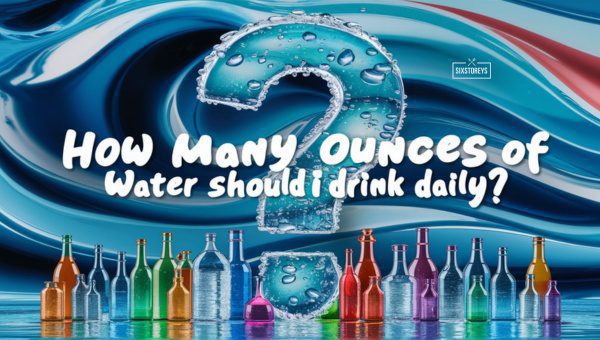How Many Ounces of Water Should I Drink Daily?
I remember the moment I realized I wasn't drinking nearly enough water. It was a regular Tuesday afternoon, and I found myself feeling inexplicably sluggish and unfocused. A quick conversation with a friend mentioned the importance of hydration, leaving me contemplating a fundamental question: how many ounces of water should I drink a day? Intrigued, I dove into research and personal experimentation, eager to understand the mysteries of proper hydration.
Turns out, staying hydrated isn't just about quenching thirst—it's about maintaining energy levels, supporting vital bodily functions, and even boosting mood. Over time, I've learned that the amount of water each person needs can vary greatly based on multiple factors, from body weight to daily activity levels. In this blog, I want to share my journey, the insights I've gathered, and tips to help you figure out your optimal water intake. So, if you've ever found yourself puzzled by how much water you should be drinking daily, keep reading; I’ve got plenty of useful information to share!

Also Read: How Many Ounces are in a Cup?
Article Includes
Why Water Intake Matters?
Hydration is more than just a trendy wellness buzzword—it's essential for keeping our bodies functioning at their best. Every part of our body, from our cells to our organs, relies on water to carry out vital processes. Water acts as a lubricant for our joints, regulates our body temperature, and aids in digestion. On a personal note, I once underestimated the power of hydration, only to experience fatigue and lack of focus, which quickly changed once I prioritized drinking enough water.
Additionally, proper hydration can have a noticeable impact on our skin, energy levels, and even cognitive functions. Think of water as fuel; just like a car won't run efficiently without the right amount of fuel, our bodies won't perform optimally without adequate hydration. Knowing this, I made a commitment to better understand how much water I really needed and to make hydration a conscious part of my daily routine.
The Standard Rule: 8x8 Rule
If you’ve ever wondered how many ounces of water should I drink a day, the 8x8 rule probably popped up as the simplest guideline. The 8x8 rule suggests drinking eight 8-ounce glasses of water a day, totaling 64 ounces. This rule is straightforward and provides a good starting point for those new to tracking their hydration.
However, it’s essential to note that the 8x8 rule is somewhat arbitrary. It doesn’t account for individual differences like body size, activity level, or climate. While it can serve as a useful benchmark, I found that tweaking my water intake to better suit my personal needs led to more noticeable improvements in my hydration levels.
Factors That Affect Water Needs
Body Weight and Muscle Mass
One of the primary factors influencing water needs is body weight. Larger individuals generally require more water to maintain optimal bodily functions. Similarly, those with higher muscle mass might need to drink more water than those with a higher percentage of body fat. For every pound of body weight, the general recommendation is to drink about half an ounce to one ounce of water daily.
Age and Gender Differences
Age and gender also play a role in determining how much water one should drink. Older adults might have a reduced sense of thirst, making it crucial to be more mindful of their hydration habits. Similarly, men and women have different water needs, often due to differences in body composition. For men, the general guideline is about 3.7 liters (125 ounces) per day, whereas women should aim for around 2.7 liters (91 ounces) daily, which includes water from beverages and food.
Activity Level and Climate
If you are physically active, especially in hot or humid climates, you’ll need more water to replace the fluids lost through sweat. When I started running, I noticed a significant increase in my water needs. To make sure I stayed hydrated, I began drinking water before, during, and after my workouts.
Here’s a simple table illustrating water needs based on activity levels:
| Activity Level | Recommended Water Intake |
|---|---|
| Sedentary | 8-10 cups (64-80 ounces) |
| Moderately Active | 9-12 cups (72-96 ounces) |
| Very Active | 13+ cups (104+ ounces) |
Personal Lifestyle Adjustments
Over time, I’ve had to adapt my water intake according to lifestyle changes. Whether it was incorporating more physical activities into my day or adjusting to seasonal changes, being mindful of these factors helped me maintain consistent hydration. For example, during summer months, I'd carry a reusable water bottle and set reminders to take regular sips.
Debunking Myths: More Isn't Always Better
The Misconception of Overhydration
One myth that has permeated our understanding of hydration is the notion that more water is always better. Excessive water intake can actually lead to a condition called hyponatremia, where the sodium levels in your blood become dangerously low. This can cause symptoms ranging from nausea and headaches to, in severe cases, seizures and even death.
Consequences of Drinking Too Much Water
I remember a time in my fitness journey when I believed that drinking water continuously throughout the day would enhance my performance. But instead of feeling energized, I felt bloated and uncomfortable. Over time, I learned that balance is key, and drinking excessive amounts of water can wash away essential electrolytes that our bodies need to function properly.
Insights from Experts
Studies and expert opinions suggest that instead of obsessing over a fixed amount, you should aim for a balanced approach. According to the Mayo Clinic, your body generally does a good job of letting you know when it's thirsty. Listening to these natural signals can be far more effective than adhering to any one-size-fits-all guideline.
Listening to Your Body: Signs of Dehydration
Recognizing the Symptoms
Dehydration can sneak up on you, especially if you are not paying attention to your body’s signals. Some of the most common symptoms of dehydration include dizziness, dark urine, dry mouth, and fatigue. Once, I went on a hike without drinking enough water and found myself feeling dizzy and lightheaded. That experience taught me the importance of recognizing dehydration early on.
My Personal Experience
I've noticed that hydration isn’t just about preventing dehydration but also about enhancing everyday well-being. On the days when I’m properly hydrated, I feel more alert and focused. Conversely, insufficient water intake leaves me sluggish and less productive. Therefore, it's vital to listen to what your body is telling you to maintain a good hydration level.
Developing a Hydration Routine
Creating a daily routine can help ensure you’re drinking enough water. For instance, I’ve set reminders on my phone to drink water at regular intervals. I also carry a reusable water bottle wherever I go, making it easier to sip throughout the day. Trust me, these small habits can make a big difference.
Signs to Watch Out For
Your body has built-in mechanisms to alert you when it needs hydration. Here’s a quick table to help you recognize these signals:
| Signal | What It Indicates |
|---|---|
| Dark Yellow Urine | Need for Immediate Hydration |
| Dry Skin | Possible Mild Dehydration |
| Rapid Heartbeat | Need for Immediate Attention |
| Lack of Sweat | Severe Dehydration |
Tools to Help Monitor Hydration
These days, there are several tools and apps available to help you monitor your water intake. I personally use a hydration tracking app that syncs with my smartwatch, providing me with real-time data on my fluid consumption throughout the day.
Tools and Tips: Making Sure You Drink Enough Water
Staying hydrated is easier said than done, especially on busy days. I've found some tools and handy tips that help me ensure I meet my water intake goals without making it feel like a chore. Here’s what works for me:
High-Tech Helpers
- Hydration Apps: I use apps like MyWater and WaterMinder. These apps send reminders throughout the day and track my intake. It’s a simple and effective way to keep myself accountable.
- Smart Water Bottles: Ever heard of smart bottles? HidrateSpark bottles, for instance, sync with an app on my phone and glow to remind me to drink water. It's not just cool tech; it’s a game-changer for staying on track.
Simple Hacks
- Set Daily Goals: Having clear, achievable goals is crucial. I set my daily water goal based on my weight and activity level. I find that breaking it down into smaller targets (e.g., two bottles by noon, four by 6 p.m.) makes it more manageable.
- Flavor Your Water: Sometimes plain water can be, well, plain. Infusing my water with slices of cucumber, lemon, or mint makes it more appealing. Plus, it feels a bit like a spa day at home.
- Always Carry a Bottle: Whether I’m heading to work or running errands, my water bottle is my trusty sidekick. This ensures I can sip throughout the day rather than chugging a lot all at once.
- Drink Water with Meals: Making it a habit to drink a glass of water before or with each meal is another easy way to boost intake without even noticing it.
Foods That Keep You Hydrated
Did you know your hydration doesn't have to come exclusively from liquids? Some foods have high water content and can significantly contribute to your daily hydration needs. Incorporating these into my diet has been a delicious and effective way to stay hydrated.
High-Water Content Foods
- Cucumbers: With about 95% water content, cucumbers are my go-to. I slice them into salads or even snack on them with a bit of hummus.
- Watermelon: This summer favorite is not only refreshing but consists of about 92% water. I love adding it to fruit salads or just having it as a quick snack.
- Strawberries: Packing 91% water, strawberries are both sweet and hydrating. I toss them into my morning yogurt or oatmeal for a hydrating start to the day.
- Lettuce: With iceberg lettuce containing 96% water, adding it to sandwiches or using it in salads helps me keep up my water intake without even thinking about it.
Easy Recipes
- Hydrating Smoothie: Blend together strawberries, cucumber, spinach, and a splash of coconut water. This smoothie is a hydration powerhouse and makes a refreshing breakfast or post-workout snack.
- Watermelon Salad: Combine juicy watermelon cubes with mint leaves, feta cheese, and a drizzle of balsamic glaze. It’s a perfect summer dish that’s as hydrating as it is tasty.
Practical Tips
- Snacking Throughout the Day: Instead of reaching for chips, I opt for high-water-content fruits and veggies. It’s a healthier choice that also helps me stay hydrated.
- Incorporate into Meals: I try to add at least one high-water-content food to each meal. This small tweak ensures I'm getting hydrated even when I’m not actively drinking water.
Making hydration a priority doesn’t have to be complicated or tedious. With the right tools and some smart dietary choices, it’s easier than ever to ensure I’m drinking enough water every day.
Conclusion
Understanding how many ounces of water you should drink a day can feel like unraveling a complex puzzle, but it doesn't have to be daunting. Through my own experiences and research, I’ve discovered that staying hydrated is essential for overall well-being. It’s been incredibly rewarding to see how small adjustments in my water intake can lead to significant improvements in my energy, focus, and even mood.
Start by paying attention to your body's signals, and don’t be afraid to experiment with different strategies to find what works best for you. Whether you adhere to the 8x8 rule, adjust based on activity levels, or focus on hydration-rich foods, the key is to remain mindful of your body’s needs. By making hydration a priority, you’re taking a crucial step towards a healthier and more vibrant life. Happy hydrating!
